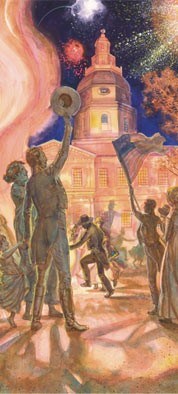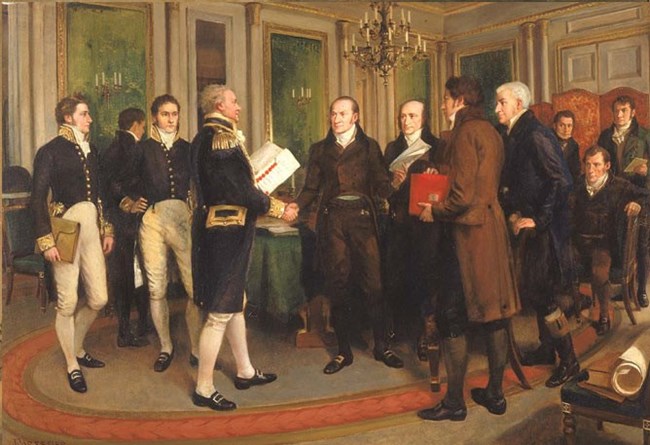
Great Britain ratified the Treaty of Ghent on December 27, 1814. A British packet ship, the Favorite, delivered the treaty to New York City on February 11, 1815. Secretary of State James Monroe received the document in Washington a few days later. The United States Senate unanimously approved the treaty, and President Madison signed it on February 16, 1815. Both sides exchanged ratified copies the next day, officially ending the war. The Octagon House in Washington, temporary residence for the first family and where Madison signed the Treaty of Ghent, was the scene of great revelry as the president and first lady hosted a party to celebrate the war’s end. As news spread, other towns celebrated the conclusion of three trying years. However, outside the populated areas of the East, news traveled more slowly, and hostilities continued in some places for several months after the official end of the war. For Indigenous peoples, the outcome of the War of 1812 brought significant consequences. With the British as their allies in earlier conflicts, Native American tribes had hoped for support in their struggles against American expansion. However, with the end of the war and the Treaty of Ghent, they lost a crucial ally in Britain. This loss paved the way for relentless westward expansion by American settlers, leading to further displacement and the erosion of Indigenous lands and cultures. The aftermath of the war set the stage for a new wave of aggressive U.S. policies that would impact Indigenous peoples forever, pushing them further from their homelands and deepening their struggles for sovereignty. 
Treaty of GhentBoth sides were weary of the war. Their delegations began negotiating for peace in August 1814. At the time, Britain held the upper hand. But US victories in September at the Battle of Lake Champlain, New York, and Baltimore, Maryland, strengthened the American position.The delegates argued over impressment, US-British North America (Canada) border disputes, and territorial issues with the Indigenous People of America. Talks dragged on—hindered by the several weeks needed to get news to and from Washington. Finally, on Christmas Eve, 1814, the negotiators signed a document that, when ratified by both governments, would end hostilities. The agreement restored “all territory, places and possessions whatsoever, taken by either party from the other during the war” as they had been before the war. Termed “status quo ante bellum”—status quo before the war—the treaty changed nothing in terms of territory. Oddly, free trade and impressment issues which had been a major cause of the war, were not mentioned in the final document as they had already been resolved. Regarding the concerns over Indigenous territories, Article IX included a clause that aimed to restore to Indigenous nations “all possessions, rights, and privileges which they may have enjoyed or been entitled to in 1811.” Unfortunately, this provision was largely ignored by the American government, and the British showed little interest in enforcing it. The losses experienced by Indigenous communities during the war had lasting and irreversible effects on their lands, cultures, and autonomy. The Treaty of Ghent, formally titled “A Treaty of Peace and Amity between His Majesty and the United States of America,” was the last peace treaty between the two nations. Gradually, the two English-speaking countries found common interests and became close allies, as they are today. |
Last updated: June 11, 2025
